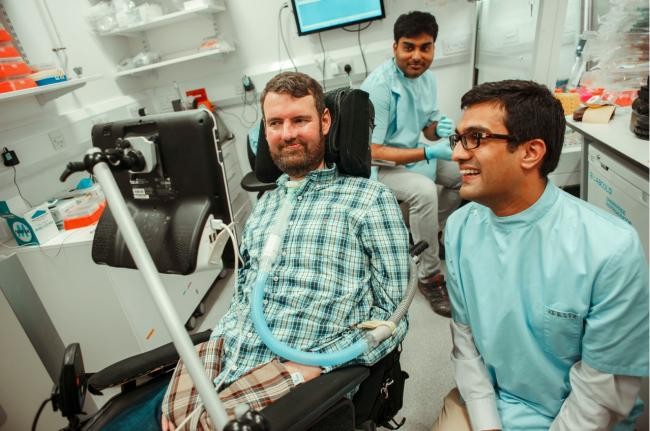
Breakthrough discovery reveals way of reversing Motor Neurone Disease damage
Published in the Herald January 17, 2021, written by Helen McArdle
SCIENTISTS are a step closer to being able to reverse the damage caused by motor neurone disease following a breakthrough discovery by researchers in Edinburgh.
The team has shown for the first time that the axon – a nerve fibre, sometimes up to a metre long, which connects and sends electrical impulses from the nerve cells to the muscle – is shorter in cells affected by MND than in healthy cells.
They also discovered that the movement of the mitochondria, which travel up and down the axons, is impaired.
However, the researchers found that the damage to nerve cells – or motor neurons – caused by MND can be repaired by boosting the energy levels in these mitochondria, the tiny ‘batteries’ which power chemical reactions in all human cells.
Once this was done, the axon reverted to normal length.
The effect was achieved in the laboratory using motor neurons grown from stem cells collected from people with a genetic mutation known to cause both MND and a form of dementia.
These laboratory-grown motor neurons were then exposed to a virus which supercharged a key molecule vital to the healthy functioning of mitochondria.
“When we did that, we found that all of the issues significantly reversed back to normal,” said Dr Arpan Mehta, who led the research for his PhD.
Dr Mehta said it could take as little as two years to test whether a drug can produce the same effect in MND patients
The scientists also examined spinal cord tissue donated by people who had died with MND.
This revealed the same problems with the axon and the mitochondria which the scientists had detected in the motor neurons grown from stem cells.
The findings have now been published in the journal Acta Neuropathologica.
The team, based at the Euan MacDonald Centre for MND Research at Edinburgh University, believe they will be able to produce the same result in patients – not with a virus, but by re-purposing an existing drug instead.
One promising candidate could be a diabetes medication which is already licensed and known to increase mitochondrial activity, but investigators will be screening hundreds of thousands of potential compounds before recommending one for human clinical trials.
A clinic founded with a donation by JK Rowling helped to fund the researchDr Mehta, a trainee neurologist, was attracted from Oxford to Edinburgh by the ‘Rowling Scholar’ regenerative neurology PhD programme – the flagship scheme run by the Anne Rowling Clinic.
The clinic was founded in 2010 with a £10 million donation from Harry Potter author JK Rowling, in memory of her mother who died of complications from multiple sclerosis.
He said the results are a “really exciting” development for MND patients.
“We believe that this technique of rescuing the axon through boosting energy will not only slow and stop but could reverse the degeneration, so it could potentially be very powerful.”
MND, also known as amyotrophic lateral sclerosis (ALS), is a progressive and incurable condition that causes muscles to waste away.
It occurs when the motor neurons, which send messages from the brain and spinal cord to the body’s muscles, stop working properly.
More than 1500 people are diagnosed with MND in the UK each year, and half of patients die within two years of diagnosis.
Dr Mehta, who carried out the study alongside Dr Bhuvaneish Selvaraj and Professor Siddharthan Chandran, said Scotland was uniquely well-placed to progress their findings into human clinical trials quickly as a result of the pioneering MND-SMART project launched last year.
The initiative, led by Edinburgh University and the Euan MacDonald Centre, is an adaptive clinical trial which brings together hundreds of patients across the UK with MND and enables multiple possible treatments to be tested at once.
Graphic of a motor neuron showing the main cell, axon and mitochondria
It means that as soon as the investigators identify a drug likely to produce the mitochondrial boost they are looking for, it can be fast-tracked straight into large-scale clinical trials – a process that might normally take 10 to 15 years.
“If you were to hand a drug that’s already safe – because it’s used in other diseases – to MND-SMART, you could basically get a result within a couple of years,” said Dr Mehta.
“Because the stark reality is, despite all the progress in modern medicine, the only drug that is licensed for this condition is riluzole, which was licensed in the mid-1990s and prolongs life by two to three months in a condition with average survival of two to three years.”
Dr Mehta added that he was delighted that his PhD project could be paving the way to a new way to treat the disease.
He said: “We’re very happy. It’s a combination of hard work and luck, but also inspiration from the environment that we’re in.
“In Siddharthan’s laboratory we often have patients coming to the lab visiting us, so that drives everyone to behave themselves and work hard.”
The study was funded by the Medical Research Council, Motor Neurone Disease Association, Euan MacDonald Centre for MND Research, My Name’5 Doddie Foundation, UK Dementia Research Institute and the Anne Rowling Regenerative Neurology Clinic.
Join our fight to #EndALS!
Sign up as to receive periodic email updates and join our circle of supporters!


